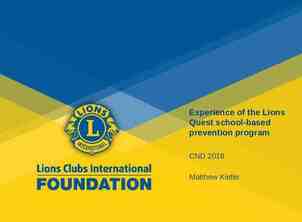COVID-19: Everyday Prevention Measures for Teachers and School Staff
19 Slides1.61 MB
COVID-19: Everyday Prevention Measures for Teachers and School Staff
OBJECTIVES Review basic information about COVID-19 and everyday prevention measures Review DC Health Guidance to help keep school staff and students safe during school reopening
COVID-19: HOW IT SPREADS COVID-19 is primarily a respiratory illness (affects lungs and breathing passages) The virus is thought to spread mainly from person-to-person – Between people in close contact with one another Close contact means being within 6 feet of someone for a total of 15 minutes over a 24 hours period – Through respiratory droplets when an infected person coughs, sneezes, or talks – People can spread COVID-19 starting 2 days before symptoms start. – People who are infected with the virus that causes COVID-19 can spread the infection even if they don’t have symptoms.
COVID-19: HOW IT SPREADS It may be possible to get COVID-19 by touching surfaces or objects that the virus is on and then touching your mouth, nose, or eyes It also may also be possible to get COVID-19 from airborne spread, particularly in enclosed, poorly ventilated indoor spaces where there are activities which produce more respiratory particles (i.e. singing, shouting, exercising, etc.) Note: The more closely a person interacts with others and the longer that interaction, the higher the risk of COVID-19 spread
COVID-19: SIGNS AND SYMPTOMS Symptoms may appear 2-14 days after exposure Symptoms range from mild to severe and can include: – – – – – – Fever or chills Cough Shortness of breath or difficulty breathing Fatigue Muscle or body aches Headache – – – – – – New loss of taste or smell Sore throat Congestion or runny nose Nausea or vomiting Diarrhea OR otherwise feeling unwell
SAFEGUARDS TO PREVENT THE SPREAD OF COVID-19 Practice Everyday Prevention Measures - Core Concept #1: Stay Home If You Are Sick - Core Concept #2: Social Distancing - Core Concept #3: Face Coverings - Core Concept #4: Hand Hygiene
EVERYDAY PREVENTION MEASURES CORE CONCEPT 1: STAY HOME IF YOU ARE SICK Stay home if you: Have any symptoms of COVID-19 Have been exposed to COVID-19 Have been instructed to quarantine (due to being a close contact of a COVID-19 case) Have been diagnosed with COVID-19 (until you have been cleared from isolation) Have a COVID-19 test pending
EVERYDAY PREVENTION MEASURES CORE CONCEPT 2: SOCIAL DISTANCING Maintain at least 6 feet of distance between you and your students Maintain at least 6 feet of distance between you and other staff members, including during break times
EVERYDAY PREVENTION MEASURES CORE CONCEPT 3: CLOTH FACE COVERINGS Staff must wear cloth face coverings or face masks at all times while at the school AND when participating in school-related activities Masks protect the wearer and protect other people It is important to maintain social distancing even when individuals are wearing face coverings Cloth face coverings or masks are NOT a substitute for social distancing
EVERYDAY PREVENTION MEASURES CORE CONCEPT 3: CLOTH FACE COVERINGS Face coverings still need to be worn during outdoor activities (except during vigorous exercise with at least 6 feet social distancing) If speaking in a noisy environment, speak louder rather than removing your face covering For more information about cloth face coverings and masks see Guidance about Masks and Other Face Coverings for the General Public at coronavirus.dc.gov/healthguidance
CHOOSING MASKS
HOW TO TAKE OFF A MASK
USE YOUR FACEMASK THE CORRECT WAY DO: Observe hand hygiene before you put on/take off facemask Make sure facemask covers your mouth and nose Facemasks should be kept clean and dry Remove facemask touching only the ear loops or ties Store in paper bag if reusing Be careful not to touch your eyes, nose, and mouth when removing Discard facemask if it becomes: More difficult to breathe through Visibly soiled or wet Damaged X DON’T: Touch your facemask or face Don’t remove or pull down your mask when talking Don’t wear your mask: Around your neck Under your nose Only on your nose On your chin Dangling from one ear Do not store your mask on your arm or in your pocket
CLEANING Cloth face coverings must be washed regularly – Include your cloth face covering with your regular laundry – Use regular laundry detergent and the warmest appropriate water setting for the material – Use the highest heat setting and leave in the dryer until completely dry
EVERYDAY PREVENTION MEASURES CORE CONCEPT 4: HAND HYGIENE Perform hand hygiene often Soap and water (wash hands for at least 20 seconds) OR Hand sanitizer (at least 60% alcohol) You must use soap and water if your hands are visibly dirty Supervise young children when they use hand sanitizer to prevent swallowing alcohol Use gloves when cleaning frequently touched surfaces Perform hand hygiene before wearing and after removing gloves
EVERYDAY PREVENTION MEASURES CORE CONCEPT 4: HAND HYGIENE Perform hand hygiene at key times: - Upon arriving to the school and before leaving Upon entering and exiting a classroom or between activities Before and after eating food Before and after preparing food or drinks Before and after giving medications or applying medical ointment After using the toilet or helping a child use the bathroom After contact with body fluid Before and after putting on, touching, or removing cloth face coverings or touching your face - After blowing your nose, coughing, or sneezing
ADDITIONAL PREVENTION MEASURES Don’t shake hands, give high-fives, elbow bump or touch others - Verbally greet or wave instead Cover coughs and sneezes Sneeze into your elbow (even if you are wearing a mask)
ADDITIONAL PREVENTION MEASURES If responding briefly to a sick student in the classroom or while escorting a sick student to school nurse: If the student is wearing a face covering (non-medical (cloth) or surgical mask), and is able to maintain 6 feet of distance, accompanying staff must wear: o Non-medical (cloth) face covering If student is not wearing a cloth face covering or mask OR 6 feet distance not able to be maintained, staff must wear: o Surgical facemask o Eye protection (face shield or goggles) o Gown o Gloves For detailed information about these issues see the COVID-19 Guidance and Resources webpage of the Office of the State Superintendent of Schools (OSSE) at osse.dc.gov/page/guidance-and-resources-covid-19-related-closures-and-recovery#healt h safety
QUESTIONS? Keep current on all the DC Health Guidance and Resources for COVID-19: https://coronavirus.dc.gov/ Phase Two Resources and Guidance https://coronavirus.dc.gov/phasetwo Follow us on social media: @ DCHealth DC Health dchealth Reach out to us: [email protected]
























